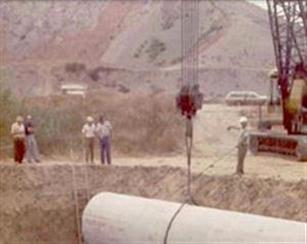When the SARI Line was completed in the mid-1970s, the pipeline was buried with as much as 20 feet of soil cover in some locations. Over the years, the riverbed has eroded and now provides only 1-foot or less of protective soil covering over portions of the upper reaches of the pipeline between the Orange/San Bernardino county line and Weir Canyon Road. During heavy rainstorms, when high volumes of storm flows are carried downstream, the loss of protective cover puts nearly 4 miles of pipeline in peril.
The U.S. Army Corps of Engineers has also raised the level of Prado Dam by 28 feet, and increased the capacity of the outlet structure, which will significantly increase the rate at which water can be discharged into the Santa Ana River. This flow of water will add to the rate of erosion of the riverbed over the SARI Line, further increasing the risk of failure. Consequently, the Corps' ability to fully utilize the newly constructed outlet structure is being limited until the SARI Line is protected.
If the pipeline were to fail, raw sewage and industrial waste would spill into the river, adversely impacting water quality and riparian habitat for the dozens of fish, birds and wildlife species that live in and along the Santa Ana River. A pipeline breach would also pollute the coastal waters and beaches in Huntington Beach and Newport Beach, which lie at the mouth of the Santa Ana River. The county's water recharge basins, which are adjacent to the Santa Ana River in Anaheim, would also be at risk of contamination. In addition, a break in the line would allow sand and large debris to enter the pipe and travel through the sewer system to the Sanitation District sewage treatment plant. This debris, if allowed to enter the plant, will damage the treatment facilities. A breach in the pipeline would also have significant impacts on Inland Empire businesses.
To ensure the long-term integrity of the pipeline, protect public health and safeguard the environment, the Orange County Flood Control District, in cooperation with the Orange County Sanitation District and the Santa Ana Watershed Project Authority, has embarked on the Santa Ana River Interceptor Relocation Project. This project will relocate and replace the SARI Mainline with a new 54-inch-diameter pipeline on the south side of the river just north of and adjacent to the Riverside (91) Freeway. In addition, a new 15-inch-diamenter gravity sewer will be constructed under La Palma Avenue and the Santa Ana River Trail to convey sewage from the north side of the river. This new pipeline will tie into the existing SARI Line behind SAVI Ranch. These new locations will protect the pipeline from the stormwater flows in the river.
The SARI Relocation Project is a component of the Santa Ana River Mainstem Project, which extends 75 miles from the river's headwater east of the City of San Bernardino to the mouth of the river at the Pacific Ocean between the cities of Newport Beach and Huntington Beach. The U.S. Army Corps of Engineers is the federal sponsor for the Santa Ana River Mainstem Project under the Water Resources Development Act (WRDA) of 1986.
 |  |
| Construction of the existing SARI Line in the mid-70's |